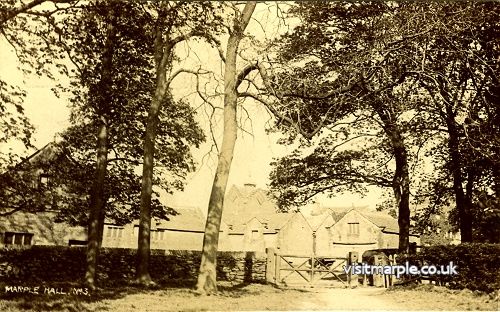 Marple Hall buildings viewed from the fields
Marple Hall buildings viewed from the fields
Transcript of cassette entitled: Richard Bradshaw-Isherwood’s notes, written in the early 1960s, read by G A Swindells
Mr Richard Bradshaw-Isherwood has sent me this resume of the history and his personal recollections of Marple Hall.
(by Bill Beard, Ruth Hargreaves & Louise Thistleton)
The original Marple Hall ……..llth century and was in the first instance the property of the Vernon Family. From the Vernons it passed by marriage to the Stanley’s from whom the family of Bradshaw purchased it, also Wybersley Hall in the year 1606. The Bradshaws came from near Bakewell in Derbyshire and they also purchased Bradshaw Hall nr Bolton in Lancashire from a much older branch of 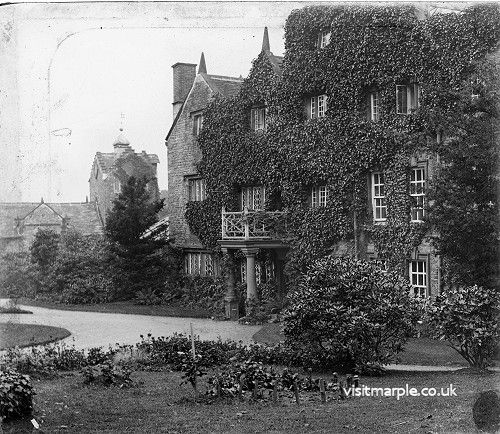 the Bradshaws who had owned it since Saxon times. Prior to the year 1606 the Bradshaws had rented Marple Hall and Wybersley from the Stanley Family. The grandson of the Bradshaw who purchased Marple Hall was the well-known judge, John Bradshaw, who sentenced King Charles I to death. He is supposed to have been born at Marple Hall in the year 1602 but is also said to have been born at Wybersley Hall or at the house called The Place in Marple, demolished about the year 1935 where the big garage now stands.
the Bradshaws who had owned it since Saxon times. Prior to the year 1606 the Bradshaws had rented Marple Hall and Wybersley from the Stanley Family. The grandson of the Bradshaw who purchased Marple Hall was the well-known judge, John Bradshaw, who sentenced King Charles I to death. He is supposed to have been born at Marple Hall in the year 1602 but is also said to have been born at Wybersley Hall or at the house called The Place in Marple, demolished about the year 1935 where the big garage now stands.
The more recent fabric of Marple Hall dates back to the middle of the 17th century when the house was largely rebuilt or altered. This more recent house, with the very deep regret and grief to all who knew it well, was pulled down about five years ago. It was built of pink sandstone and stood from the back at a height of 250 feet on top of a cliff, looking from the back down into fields and beyond to the Turncliffe Wood and hill and beyond to Werneth Low. From the Bradshaw family it passed by marriage to the Isherwood’s who emanated from Bolton. The last of the Bradshaw family to occupy it was Mary Bradshaw who inherited it from her brothers, both of whom died childless. She married first a Mr Pimlott (William) by whom she had a daughter from whom Lord Dunseenly (?) is descended. Secondly she married Mr Nathaniel Isherwood by whom she had two sons. Thus the Isherwood family came into ownership of the estate and adopted the additional surname of Bradshaw before their own name of Isherwood, hyphenating the two names. This was in the year 1761. Mary Bradshaw was born in the year 1674 and died in the year 1761 surviving both her husbands.
The house was not properly occupied as a family residence after the death in May 1924 of Mr John Bradshaw Isherwood who, I believe, died in the bed in which he was born at Marple Hall on August 27th 1841 and this bed was the one in which according to tradition Judge Bradshaw was born. After the death of Mr John Bradshaw Isherwood the house was occupied by successive caretakers 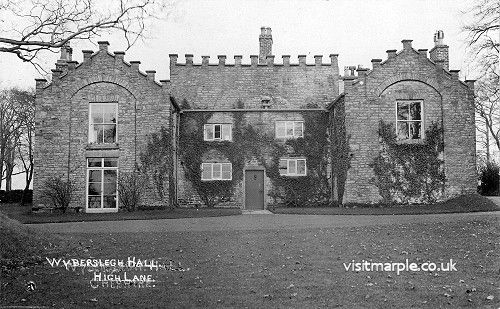 until 1953. The great part of the antique furniture and household effects were sold in the year 1929 excepting the family portraits and a few other effects. These are now in Wybersley Hall, High Lane, still retained by the Isherwood family. Wybersley Hall was purchased in 1606 as a residence for the heir presumptive to the estate but was actually rented to various people over a long period.
until 1953. The great part of the antique furniture and household effects were sold in the year 1929 excepting the family portraits and a few other effects. These are now in Wybersley Hall, High Lane, still retained by the Isherwood family. Wybersley Hall was purchased in 1606 as a residence for the heir presumptive to the estate but was actually rented to various people over a long period.
As has been said, Marple Hall was once of great importance to the people of Marple, as is Buckingham Palace to the whole of Great Britain, but today its very existence is largely forgotten in a newer and ever increasing suburbanised Marple. No account of Marple Hall would be adequate without mention of the ghosts, the respectively reputed and authenticated ones. Re the former, she is said to have been a certain Esther Bradshaw, daughter to Col Henry Bradshaw, who was then owner of Marple Hall, a Cromwellian soldier and a personal friend of Oliver Cromwell. Incidentally Oliver Cromwell is reputed to have been a guest at Marple Hall and, as you would probably know, the bridge over the brook at the foot of the steep hill in what was the lower drive leading to Dooley Lane is known as Oliver’s Gig because according to tradition he fell off his horse there when he was staying at Marple Hall.
Esther Bradshaw was engaged to a young royalist soldier, one of the Cheshire Leighs. Her family were of course all roundheads but nevertheless they were fond of her fiancé and approved of the engagement. One night while the Civil Wars were raging he arrived for 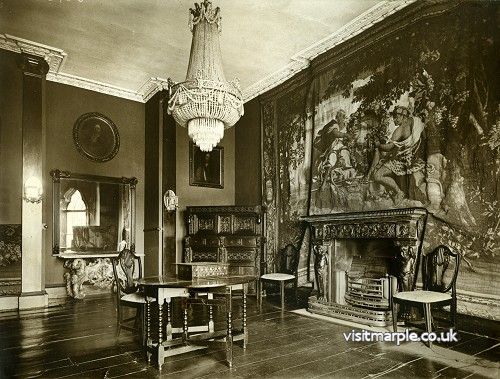 Marple Hall Drawing Room in 1919. You can just see the cut-out section of the priceless tapestry far left of the image. This tapestry was purchased by William Randolph Hurst in 1929 and is now restored in the Art Institute of Chicago.the night at Marple Hall to see his ladylove. He said that he would have to be off early next morning as he had to deliver some very important letters to King Charles I who was then at Chester. He said he had no idea of the nature of the letters. However, when she heard him say this, Mrs Bradshaw, the mother of his ladylove, pricked up her ears as she thought the letters might well be adverse to the interest of her husband, Col. Bradshaw, a confirmed Parliamentarian. While the family were at supper she and a French manservant went and ripped open the young man’s saddlebags and read the letters which confirmed her worst fears as they denounced her husband to the King. So, after they had sown up the bags, Mrs Bradshaw told the manservant to be sure to go with the young man when he departed next morning and above all to make certain of holding onto the bags until he had crossed the ford below the house, now the grotto meadow. While he was looking the other way he had to throw the bags with the letters in them into the deepest part of the mere. The manservant decided he would go still further and the next morning, when young Mr Leigh went away and he escorted him across the mere, he not only held onto his saddlebags but pointed out to him the deepest part of the water. The young soldier, in ignorance, followed his advice with the result that, half way across the stream, his horse floundered. Both it and he were carried away and drowned.
Marple Hall Drawing Room in 1919. You can just see the cut-out section of the priceless tapestry far left of the image. This tapestry was purchased by William Randolph Hurst in 1929 and is now restored in the Art Institute of Chicago.the night at Marple Hall to see his ladylove. He said that he would have to be off early next morning as he had to deliver some very important letters to King Charles I who was then at Chester. He said he had no idea of the nature of the letters. However, when she heard him say this, Mrs Bradshaw, the mother of his ladylove, pricked up her ears as she thought the letters might well be adverse to the interest of her husband, Col. Bradshaw, a confirmed Parliamentarian. While the family were at supper she and a French manservant went and ripped open the young man’s saddlebags and read the letters which confirmed her worst fears as they denounced her husband to the King. So, after they had sown up the bags, Mrs Bradshaw told the manservant to be sure to go with the young man when he departed next morning and above all to make certain of holding onto the bags until he had crossed the ford below the house, now the grotto meadow. While he was looking the other way he had to throw the bags with the letters in them into the deepest part of the mere. The manservant decided he would go still further and the next morning, when young Mr Leigh went away and he escorted him across the mere, he not only held onto his saddlebags but pointed out to him the deepest part of the water. The young soldier, in ignorance, followed his advice with the result that, half way across the stream, his horse floundered. Both it and he were carried away and drowned.
His ladylove, Esther, was reputedly waving goodbye to him from the terrace behind the house and saw him drowned .She fell on the ground in a swoon. On recovery she was half out of her mind for the rest of her life, which she spent in wandering through the wood on the side of the hill on that side of the house, bewailing the loss of her lover. This wood is known as the Lady Wood, called after her. However when the mere was drained of water over a 100 years ago a horse’s bridle and spurs were discovered in the mud and which were preserved at Marple Hall until the general sale in 1929. I am afraid I cannot accept this story. For one thing I have never once heard of anybody encountering Esthe r’s phantom. Also there is no record of a daughter called Esther in the family pedigree or any daughter old enough at the time of the Civil Wars to have had a lover. Also, from the diary of a visitor at Marple Hall, the Reverend Charles Bellairs, who subsequently married Anna Maria Isherwood, one of the daughters of John Isherwood who died in 1839, there is no mention of any ghost or of this above-mentioned story something which surely he had heard about and would have mentioned if it had any foundation. My own opinion is that it was concocted in later years.
r’s phantom. Also there is no record of a daughter called Esther in the family pedigree or any daughter old enough at the time of the Civil Wars to have had a lover. Also, from the diary of a visitor at Marple Hall, the Reverend Charles Bellairs, who subsequently married Anna Maria Isherwood, one of the daughters of John Isherwood who died in 1839, there is no mention of any ghost or of this above-mentioned story something which surely he had heard about and would have mentioned if it had any foundation. My own opinion is that it was concocted in later years.
(Two ladies enjoy a stroll along the main tree lined drive to Marple Hall
The other ghost, known as Moll of Brabyns, is entirely authentic although her identity is questionable. She is said to have been Elizabeth Brabyns or Brabin, daughter of a Doctor Brabyn who built the original of Brabyns Hall, later the residence of the Hudson Family. She married Nathaniel Isherwood, the elder son of Mary Bradshaw and her second husband, Nathanial Isherwood, in the year 1765. He died a few months after their marriage and his brother is said to have turned her out of the house. In consequence of this she held a bitter resentment against her husband’s family and is said to have haunted the room, presumably once her bedroom. This was known as the old nursery and particularly she was said to have resented young children occupying it because if her husband had survived long enough for her to have a child of her own she would not have been evicted. There is absolutely no doubt that this room was haunted and possibly someone occupying it who had a little dog as denoted in the portrait, a grim forbidding-looking , brown-eyed lady with a long neck, and long slim fingers ,one arm outstretched under which there is a dim figure of a small black and white dog. This portrait was left behind at Marple Hall after the other effects were removed to Wybersley as it was supposed to bring ill luck to anyone who removed it either from Marple Hall or from its place on the front stairs. Various members of the family claim to have seen this ghost, always in the room known as the old nursery, a room on the second storey ,a wide airy room facing north and east.
In the summer of the year 1907 a member of the family, Christopher Isherwood , now living in California, then a boy of three years old, stayed in charge of his nurse at Marple Hall with his grandparents while his father and mother were on holiday. He and his nurse 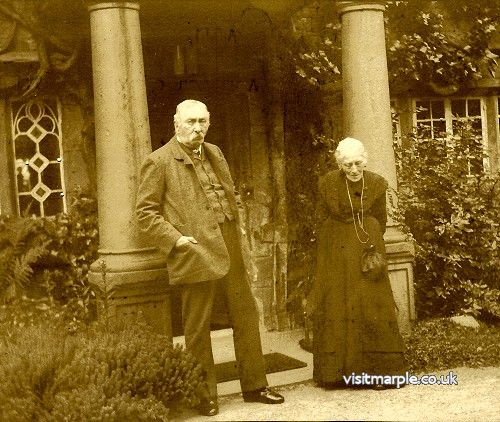 John Henry Bradshaw-Isherwood (b1841) and wife Elizabeth (b1836) outside Marple Hall c1907occupied the room known as the old nursery and which, in spite of the rumour attached to it, had for some reason been used as a children’s nursery from time to time. During their stay there the little boy was each night awakened in the small hours of the morning by what he called a “muzzy old woman” who he said was sitting on the end of his bed and who held a little dog in her arms. The nurse saw nothing but felt a presence in the room. Later in the same year, 1907, the child was again said to have stayed at Marple Hall in charge of his nurse. On the first night of their arrival his nurse left him asleep in the room with the night light burning and with the door open while she went downstairs to have supper in a room known as the Servants Hall along a passage on the ground floor. Before they had been long at supper they thought they heard a sound like a foot step in the passage outside and, on going into the passage, found Christopher standing in the passage on the bare stone floor. The nurse said that it looked as if someone or something seemed to vanish behind the angle of the wall. On being asked how on earth he had managed to climb out of his cot and come down two flights of stairs he replied quite calmly and firmly, “Daddy put on the light and carried me downstairs.” They told him not to tell lies. His father was at that moment on holiday in Spain.
John Henry Bradshaw-Isherwood (b1841) and wife Elizabeth (b1836) outside Marple Hall c1907occupied the room known as the old nursery and which, in spite of the rumour attached to it, had for some reason been used as a children’s nursery from time to time. During their stay there the little boy was each night awakened in the small hours of the morning by what he called a “muzzy old woman” who he said was sitting on the end of his bed and who held a little dog in her arms. The nurse saw nothing but felt a presence in the room. Later in the same year, 1907, the child was again said to have stayed at Marple Hall in charge of his nurse. On the first night of their arrival his nurse left him asleep in the room with the night light burning and with the door open while she went downstairs to have supper in a room known as the Servants Hall along a passage on the ground floor. Before they had been long at supper they thought they heard a sound like a foot step in the passage outside and, on going into the passage, found Christopher standing in the passage on the bare stone floor. The nurse said that it looked as if someone or something seemed to vanish behind the angle of the wall. On being asked how on earth he had managed to climb out of his cot and come down two flights of stairs he replied quite calmly and firmly, “Daddy put on the light and carried me downstairs.” They told him not to tell lies. His father was at that moment on holiday in Spain.
They took him upstairs again but when they got to the room they found the door was shut. On trying to open it something seemed to be pressing against it from the inside. Very mystified and rather scared they fetched the child’s uncle who, with two men friends, was  Exquisite antiques in the Dining Room of Marple Hall.staying there with his father and mother. They managed to get the door open and then it was found that a heavy chest of drawers from the other end of the room had been placed against the door, the electric light was turned on and the child’s cot side let down. The reasonable supposition could have been that it was a burglar who the little boy might have mistaken for his father and, who, after carrying him down the stairs had barricaded himself in the room and then climbed out of the window. This was out of the question as both the windows were much too small for anyone to pass through, nor was there anyone in hiding in the only cupboard. I have heard this story first hand from the child’s uncle, the late Mr John Bradshaw Isherwood, who was staying in the house at the time and who was fetched to the scene to go and get the door open. Seven years later, almost to the day, the child’s younger brother had a rather strange but brief experience when he was sleeping in the same room and thought he saw an apparition. Oddly enough this occurred on the first Sunday in October which was also the date on which the child’s brother was carried downstairs. This ghost story is absolutely authentic and without question the child’s mother was convinced that it was his guardian angel that night who took the form of his father so that he would not be frightened and to protect him from something harmful or evil in the room.
Exquisite antiques in the Dining Room of Marple Hall.staying there with his father and mother. They managed to get the door open and then it was found that a heavy chest of drawers from the other end of the room had been placed against the door, the electric light was turned on and the child’s cot side let down. The reasonable supposition could have been that it was a burglar who the little boy might have mistaken for his father and, who, after carrying him down the stairs had barricaded himself in the room and then climbed out of the window. This was out of the question as both the windows were much too small for anyone to pass through, nor was there anyone in hiding in the only cupboard. I have heard this story first hand from the child’s uncle, the late Mr John Bradshaw Isherwood, who was staying in the house at the time and who was fetched to the scene to go and get the door open. Seven years later, almost to the day, the child’s younger brother had a rather strange but brief experience when he was sleeping in the same room and thought he saw an apparition. Oddly enough this occurred on the first Sunday in October which was also the date on which the child’s brother was carried downstairs. This ghost story is absolutely authentic and without question the child’s mother was convinced that it was his guardian angel that night who took the form of his father so that he would not be frightened and to protect him from something harmful or evil in the room.
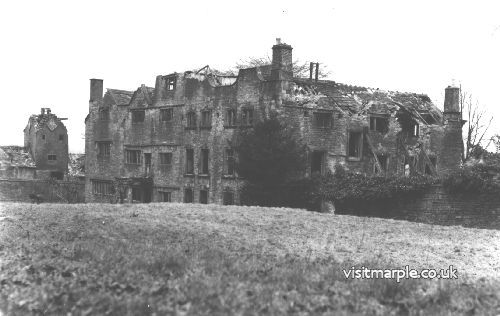 Marple Hall Demolition 1954
Marple Hall Demolition 1954
Judge Bradshaw, being a younger son, did not succeed to Marple Hall or Wybersley, property which was inherited by his eldest brother, Col Henry Bradshaw, who lived for 20 years at Wybersley as heir presumptive and who died at Marple Hall about 1663. Judge John Bradshaw is reputed to have written on a gravestone in a churchyard in Bumbury where he was at school, My brother, Henry, shall heir the land, my brother, Frank, shall be at his command while I, poor Jack, shall do that which all the world shall wonder at. This verse was written in the window of the Bradshaw room at Marple Hall which was the bedroom of Mr John Bradshaw Isherwood. Judge Bradshaw died in the year 1657 at Walton-on-Thames near London, predeceasing the Protector, Cromwell, by one year. He was buried in Westminster Abbey but at the Restoration his remains, with those of Cromwell and Cromwell’s son-in-law, Ireton, were exhumed, hung drawn and quartered on the gallows at Tyburn, close to the site of the Marble Arch. This was on the 30th January 1661, the anniversary of the day on which King Charles I was executed.

